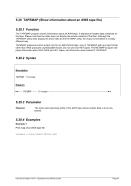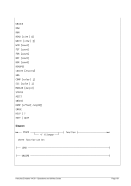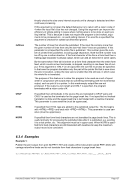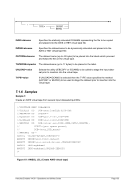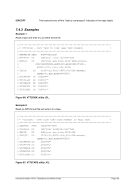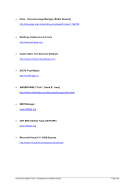6.2.8.2.2 [fieldname] Line=, Column=, Width=
Each "[fieldname]" sub-section following the primary [FieldNames] section should match one of the field
names defined in one of the "Name#=" entries. Note that it is not considered an error if it does not match
any of your defined "Name#=" entries. Rather, it will simply never be used. The reverse however is not
true. For each field name defined by a "Name#=" entry, a corresponding "[fieldname]" section must exist
or it is considered an error.
The "Line=", "Column=" and "Width=" values define where on the page that particular field is located. Just
like the "Line=" and "Column=" values of the [Separator] section, the line and column number values are
1-relative. A "Width=" value of 0 is invalid, but a width value of -1 means the field extends through to the
end of the print line.
Whenever a job separator page is detected (as defined by the [Separator] section) all job accounting field
values are extracted and saved according to the information contained in your [fieldname] sections. All
defined job accounting field names are case sensitive and all extracted field values have their leading and
trailing blanks removed before being saved.
6.2.8.3 [Output File] section
The [OutputFile] section contains a single "Name=" entry which defines how the job accounting fields
must be used to construct the spooled report's filename. Job accounting fields are defined in the
[FieldNames] section and their values are extracted directly from the job separator page and saved for
use by the [OutputFile] section's "Name=" entry. Each percent sign enclosed string within the "Name="
value is substituted with one of the defined job accounting field values.
If, for example, have the following job accounting field defined in your [FieldNames] section and the con-
tents of the job separator page’s 58th line happens to be a "Name=" setting of "Job %JOBNAME%.txt"
then this would result in the spooled report file being named "Job FOOBAR.txt".
Please note that Windows filenames cannot have any characters in them whose integer representation is
within the range of 0 through 31 (i.e. x'00' to x'1F') nor can they contain any of the following reserved cha-
racters:
< > : " / \ | * ?
Further note that the length of a file’s complete path specification cannot exceed the standard Windows
operating system path length restriction of 260 characters total, so try to limit your output filename to the
minimum needed while still ensuring that the resulting names remain different from one another.
After constructing an initial output filename based on your defined "Name=" value (which should be con-
sidered only a template), HercPrt then applies further string and character translations as defined in the
[Translations] section before attempting to rename the file to its final name.
If during the construction of the output filename it is detected that a file already exists with that name, then
"-2" is appended to the generated name and that is used instead. If a file with that name already exists
then "-3" is appended, and so on, all the way to "-10". If a unique filename still cannot be constructed after
trying "-10", then a warning is issued and the file is left with its original Windows assigned temporary file-
name (e.g. "PRT305.tmp").
The filename extension of your "Name=" value is used to determine what format the spooled file should
be created in. If the "Name=" template ends with ".txt" the output file will be in plain text format (the
default). If it ends with ".html" then it will be in HTML format, etc. Other supported filename extensions are
".rtf" and ".pdf". If the filename does not end with one of the supported filename extensions (txt, html, htm,
rtf or pdf) then the file is created in text format by default.
If the output filename extension is either .rtf or .pdf then additional file formatting options may be specified
via the [PDF] section.
6.2.8.4 [Translations] section
The [Translations] section allows you to further customize your output filename by allowing you to define
character and string substitutions to take place during output filename construction.




























































































